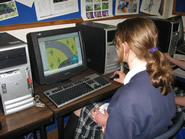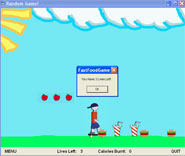Pre-planning

Katie de Lange developing the user interface her sister has chosen from the concepts Katie designed.
In 2005, Jenny and fellow Hillcrest Technology teacher Karllie Clifton formed a Beacon Practice cluster with two members of the Katikati College ICT department. The aim of the group was to generate ideas and broaden their teaching approaches. Jenny incorporated insights she gained at cluster meetings from Beacon Practice Professional Support Facilitators Cliff Harwood and Hugh Derham into her teaching programme.
Planning for the course focussed on finding ways to embed technological practice seamlessly into the development of a project. Jenny wanted her students to value the technological approach, rather than consider it an addition to their workload. She aimed for a good balance between skill development, good technological practice, creativity and innovation.
Student practice is project-driven rather than Assessment Standards driven, says Jenny. Students work on a "real problem for a real-life situation" and aim to satisfy the needs of stakeholders and a client. They learn and use whatever software application is appropriate. The Standards are laid over the whole project and Assessment criteria picked out as appropriate.
Jenny split the year into three project modules. The first two modules were done in term one, and aimed to develop skills and make the students comfortable with good technological practice. The third was a major project extending these skills and understandings through producing a quality outcome.
For 2006, Jenny chose a theme entitled 'Confident Kids' in which student were challenged to investigate young peoples' specific learning needs and plan, design, program, test and implement a computer program to meet those needs.

Bjorn created a Fastfood computer game to enable his little sister to become more confident in the benefits of eating healthy food.
s the character skateboards through the game, the player learns the calorie values of junk food, and the potential to lose lives from not avoiding the bad milkshakes and hamburgers that plague our fastfood society.
Resources covering programming, interface design, and inclusive software design (to serve the needs of people with disabilities), were assembled and placed on the school intranet for ease of access. These included a Confident Kids project resource page with links to resources such as assessment requirements, planners, milestones glossary and tasks checklist.
"We also used some Natcoll resources, which are good for students learning new applications," says Jenny. "Students can pick them up when needed and learn the skills on their own. The resources I create are to encourage higher level thinking - to extend students in particular directions in which they have shown interest, or to show them alternative ways to solve design and programming problems."
Project development was structured around The Diagram, a resource Jenny developed in 2005 when more than half of her students used English as their second language and struggled with the language of technology. "This was full-wall diagram explaining key words through all stages of the technological process, which was later simplified to fit on to an A4 page. It helps all students get the 'big picture' of what they were being asked to do by seeing the process in a more visual form."